When to Apply Pre-Emergent in North Texas
No matter where you have a lawn, particular challenges are common to everyone, mainly concerning maintaining a healthy lawn appearance. Weeds can significantly harm lawn health, so there’s a substantial effort, including education, to prevent their occurrence in time.
Pre-emergents are key players in this game. These specialized herbicides are applied at a specific time to prevent weeds from sprouting and rooting. If not treated on time, weeds will deteriorate the health and appearance of the lawn by stealing nutrients and water.
The importance of using pre-emergents is immeasurable, as later you’ll see the result in a beautiful, lush, and well-maintained lawn. If you are a proponent of a proactive approach and don’t want to leave things to chance, you’ll undoubtedly opt for using pre-emergents because, in the long run, you save time, effort, and money.
Like other parts of Texas, North Texas has challenges regarding lawn care. This region’s hot summers and mild winters create a unique environment for grass care. Unlike the southern parts of Texas, North Texas experiences greater temperature variations, which can stress the lawn and make it more susceptible to weeds and diseases. Due to these circumstances, pre-emergents are commonly used.
Learn about:
- How pre-emergents work in weed control
- The best time to apply pre-emergents
- Factors that affect the timing of application
- Step-by-step instructions on how to use pre-emergents
- Mistakes to avoid when using pre-emergents
- Benefits of using pre-emergents
- Expert tips
Let’s start step by step.
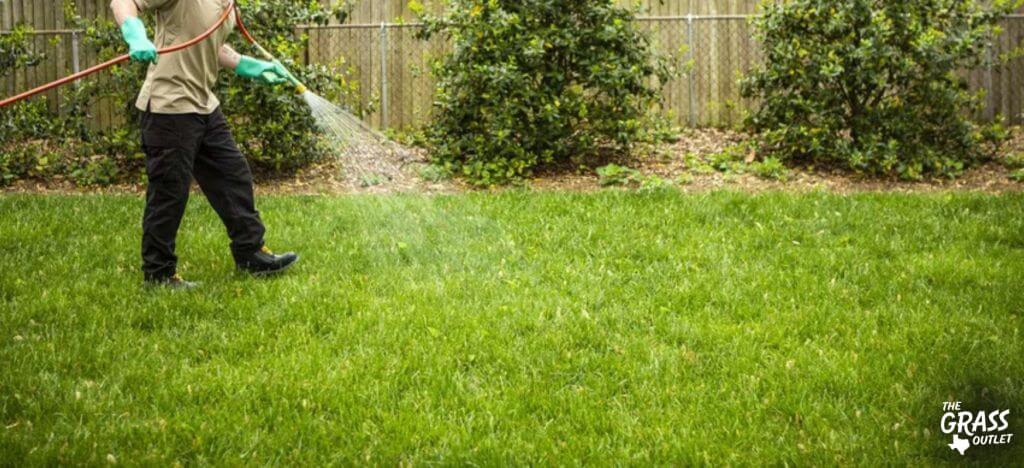
How Do Pre-Emergents Work in Weed Control?
Pre-emergents are specialized chemical formulations used to prevent the germination and growth of weed seeds. They are applied to the soil before the weeds appear, forming a chemical barrier that inhibits the development of new root cells in young weed seedlings. This process ensures that the seedlings cannot feed and grow, eventually leading to their death.
The active ingredients in pre-emergent herbicides, such as dithiopyr,, and prodiamine, create a chemical barrier in the upper soil layer. This barrier coats the weed seeds and prevents them from developing roots and shoots. When the seed attempts to germinate, the herbicide stops forming new root cells, effectively killing the seedlings before they can emerge from the soil.
Pre-emergent herbicides target the sensitive root tissue of newly germinated seedlings, preventing them from establishing. However, they are not effective against vegetative buds that sprout from existing roots or rhizomes, nor should they be used on prepared seedbeds for grass, as they can interfere with the growth of young grass plants.
Many believe pre-emergent herbicides kill seeds directly, but this is false. Instead, when a germinating seed encounters the herbicide, it halts cell division in the young root, causing the young root to die. These products typically do not affect existing plants, so removing all existing weeds from the area is essential before applying the pre-emergent herbicide.
When to Use Pre-Emergent Herbicides in North Texas – Timing Is Everything
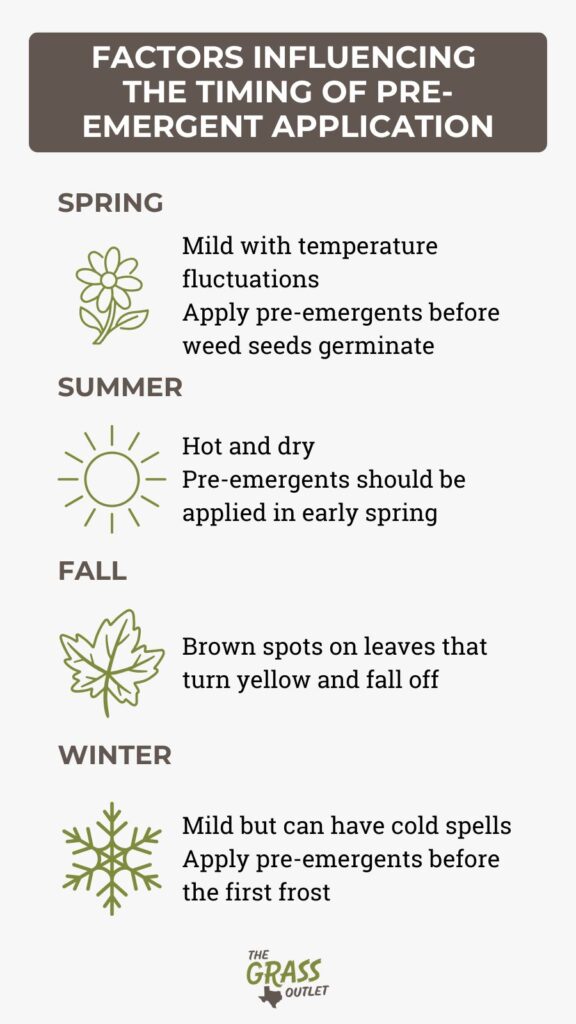 Pre-emergent herbicides work by preventing weed seeds from germinating. If applied too early, they may lose effectiveness before the seeds germinate. The seeds may have germinated if applied too late, rendering the herbicides ineffective.
Pre-emergent herbicides work by preventing weed seeds from germinating. If applied too early, they may lose effectiveness before the seeds germinate. The seeds may have germinated if applied too late, rendering the herbicides ineffective.
Proper timing allows the herbicide to be adequately absorbed into the soil, which is necessary for its effectiveness. This means it must be activated by timely rainfall or irrigation.
Applying herbicides when the grass is least active reduces the risk of damaging it, allowing it to remain healthy and resilient against weed invasion.
Weeds appear depending on the season; some thrive during warmer months, while others emerge when temperatures significantly drop. Apply pre-emergent herbicides according to what grows in your yard.
Apply pre-emergent herbicides from August to November to target weeds germinating when temperatures drop. Consider a fall application even if your grass looks weed-free at the beginning of the fall.
Applying pre-emergent herbicide in the fall is recommended when soil temperatures reach 70 degrees and continue to fall. To check the soil temperature, insert a thermometer 2 inches below the soil surface.
Weeds specific to late spring and summer develop and produce seeds during the summer and die when the first frost occurs. To prevent their appearance, apply pre-emergent herbicide in early spring (around mid-March), after grass or flowers start growing but before weeds germinate.
The timing of the application must be precise to avoid destroying all seeds or inhibiting root growth in the soil (for example, if you planted new grass). Apply pre-emergent herbicide when the soil temperature is 55 degrees for four to five days.
Tip: To stay ahead in the fight against weeds, you must know what types of weeds grow in your yard and what time of year they thrive. Ensuring the soil temperature is ideal for maintaining a weed-free yard is also crucial.
Monitor the weather forecast before applying pre-emergent herbicide to avoid being washed away by summer rain or blown away by the wind. Temperatures should be warm and relatively moist, but not too much, as dew can dilute the herbicide and reduce its effectiveness. Wait until the soil is completely dry before applying the herbicide, especially if there has been a lot of rain.
Factors Influencing the Timing of Pre-Emergent Application
North Texas has a mild climate. In spring, pleasant temperatures prevail, with occasional late frosts. However, spring is characterized by significant temperature fluctuations, making determining the timing of pre-emergent herbicide application challenging.
Summer is dry and warm, with temperatures exceeding 90°F (32°C). Soil temperatures can rise quickly, so it’s essential to apply pre-emergent herbicides in early spring before weed seeds begin to germinate.
Fall is mild, like spring, but with common and unpredictable rainfall. Fall application of pre-emergent herbicides is crucial for controlling winter annual weeds.
Winters are generally mild but can experience sudden cold spells. While soil temperatures rarely fall below freezing for long periods, it is important to apply pre-emergents before the first frost.
Applying Pre-Emergent Herbicides Based on Soil Temperature
Most pre-emergent herbicides are effective when applied before weed seeds begin to germinate. For many common weeds like crabgrass, the herbicide is applied when soil temperatures consistently reach 55°F (approximately 13°C) for several consecutive days. In North Texas, this usually occurs between late February and early March.
How to Determine Soil Temperature
Use a soil thermometer to check the temperature at 1-2 inches depth. Consistent monitoring is crucial as soil temperature varies quickly, especially during transitional seasons.
Impact of Soil Type on Pre-Emergent Herbicide Application
Different soil types, from sandy to clayey, are found throughout North Texas. The effectiveness of pre-emergents depends on soil type, requiring adjustment in application timing and quantity.
Sandy soil quickly drains water and herbicides, while clayey soil can retain water and herbicides longer.
Prolonged drought is not uncommon in Texas, and high temperatures can stress lawns, making them more susceptible to weed invasion. Therefore, it’s essential to maintain appropriate lawn care practices, including adequate watering, to ensure the effectiveness of herbicide application.
Monitor Weather Forecasts
Rapid changes from cold to warm weather in spring and fall can make determining the optimal time for applying pre-emergent herbicides difficult. Unpredictable rainfall can wash away applied herbicides before they become effective. Weather forecast monitoring is key, and herbicides should be used during expected dry periods.
In spring and early summer, North Texas is prone to extreme weather events, including severe storms, hail, and occasional tornadoes. In recent years, there has been a trend for spring to start earlier and for falls to be warmer.
Applying Pre-Emergent Herbicides – Step by Step
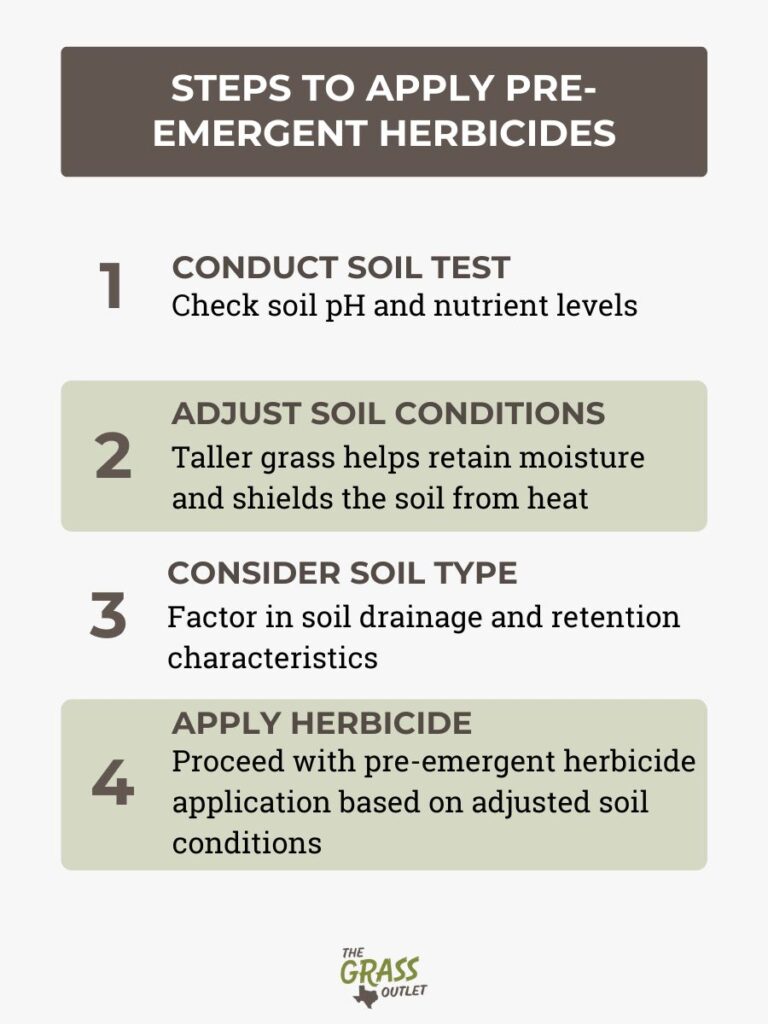
The effectiveness of herbicides is significantly influenced by soil composition and pH value. The ideal pH value for most lawns is between 6.0 and 7.0. If the soil pH is too acidic (below 6.0) or too alkaline (above 7.0), it can affect how effectively the applied herbicide will work.
Conduct a soil test to understand the soil’s pH value, structure, and nutrients. These factors can influence the choice of herbicide and its effectiveness. If the test shows a lack of certain nutrients, you can apply appropriate fertilizers to improve lawn health before applying pre-emergent herbicides.
Once you add the necessary substances to the soil and achieve this ideal pH value, you can proceed with herbicide application.
It’s also important to know that different soil types (sandy, loamy, clayey) have different characteristics that can affect herbicide application. For example, sandy soil drains water and herbicides quickly, while clayey soil can retain water and herbicides longer.
How does the application process work?
First, you will need the appropriate tools and type of pre-emergent herbicide (granular or liquid), and then follow the step-by-step, systematic application.
Granular herbicides are quickly prepared—you only need a spreader to skillfully spread them over the entire surface. This type is generally recommended for smaller lawns and is cheaper than liquid herbicides.
When using liquid herbicides, you will need to be more precise. They are better for larger areas, allowing you to cover them quickly and evenly. Additionally, they require less watering after application compared to granular herbicides.
How to Prepare and Apply Granular Pre-Emergent Herbicide
Purchase the specific granular herbicide (depending on the weeds you need to prevent in your lawn) and a spreader (if you don’t already have one). You will also need chemical-resistant gloves, long-sleeved work clothing, safety goggles, socks, and shoes.
First, study the label to see the recommended dosage. Take the recommended amount according to the size of your lawn and prepare it in the spreader. Calibrate the spreading to match the area of your yard. Determine the spreading distance by choosing the rotation speed on your spreader. A higher rotation speed means a wider granule spread, which is ideal for wide planting beds.
Tip: For best results, walk in opposite directions over the target area and release the handle on your equipment. Your walking pace will affect the amount of product applied to the yard, so maintain a consistent pace for even application.
To avoid uneven application, go over the same area several times without exceeding the necessary dose.
After completing the application, water thoroughly with ½ to 1 inch of water to ensure proper absorption.
How to Prepare and Apply Liquid Pre-Emergent Herbicides
If you didn’t receive a sprayer when you purchased liquid herbicide, buy a portable pressurized sprayer (available in various sizes). You will need the same protective equipment as with granular herbicides: gloves, work clothing, safety goggles, socks, and shoes.
Mix the liquid pre-emergent herbicide with water as described in the instructions. Apply it evenly to the targeted area of the yard, row by row, similar to mowing the lawn.
After application, wait 12 to 24 hours for the liquid to absorb and the grass to dry, then resume your regular watering schedule.
Which Pre-Emergent Herbicides Are Best?
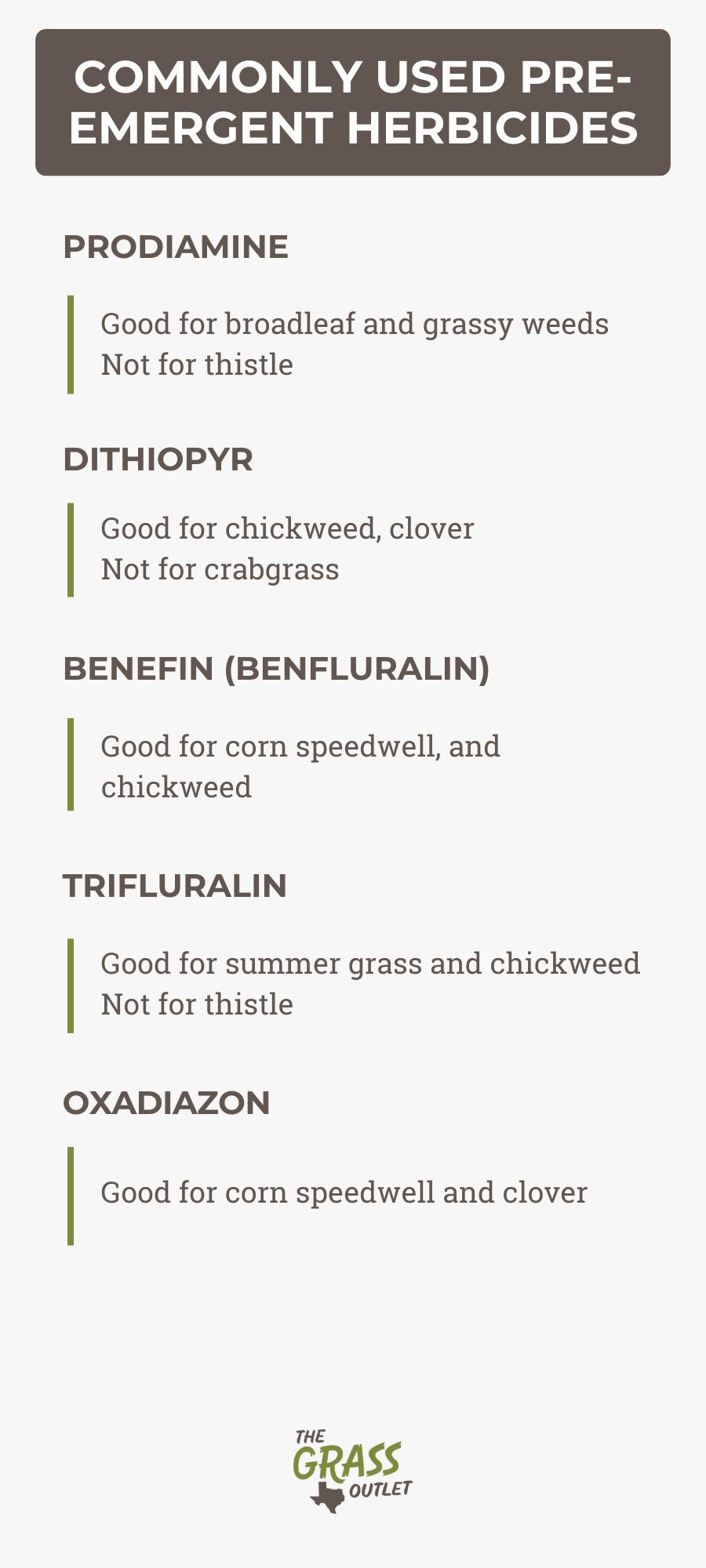
Here are some commonly used herbicides:
- Prodiamine:
- It effectively prevents broadleaf and grassy weeds such as chickweed, henbit, clover, burweed, corn speedwell, creeping speedwell, and dandelion. However, it is not very effective against thistle. It can be safely used on established lawns.
- Dithiopyr:
- It is effective in preventing chickweed, sorrel, clover, dandelion, bittercress, corn speedwell, goosegrass, and poa annua. However, it cannot combat crabgrass and broadleaf weeds.
- Benefin (also known as Benfluralin):
- It prevents the growth of corn speedwell, carpetweed, chickweed, annual bluegrass, sandbur, burweed, and knotweed.
- Oxadiazon:
- It prevents the growth of corn speedwell, clover, dandelion, burweed, and knotweed.
What to Know Before Applying Pre-Emergent Herbicide
Weather Conditions:
- No Wind: Apply herbicides when there is no strong wind to avoid dispersing the herbicide onto unwanted areas.
- Dry Weather: It is best to apply the herbicide when no rain is expected for at least 24 to 48 hours after application. This allows the herbicide to bind to the soil surface.
- Soil Temperature: As previously mentioned, monitor the soil temperature.
Lawn Preparation:
- Clean Lawn: Remove leaves, twigs, and other organic debris before applying the herbicide to ensure even distribution.
- Mowing the Lawn: Mow the lawn to the recommended height before applying the
herbicide to ensure it reaches the soil.
Safety Measures:
- Protective Gear: Wear protective equipment, including gloves, safety goggles, long sleeves, and pants, to protect yourself from contact with the herbicide.
- Children and Pets: Keep children and pets away from treated areas until the herbicide is completely dry and absorbed into the soil.
After applying pre-emergent herbicides, it is recommended to water the grass and avoid walking on it.
Mistakes in Applying Pre-Emergent Herbicides and How to Avoid Them
When applying pre-emergent herbicides, mistakes often occur that can reduce their effectiveness or even damage the lawn.
If the herbicide is applied too early, before the soil temperature reaches the optimal level (around 55°F or 13°C), the herbicide can become ineffective before the weeds germinate. Therefore, the soil temperature should be monitored with a thermometer, and the herbicide should be applied when the temperature consistently reaches 55°F for several consecutive days.
If the herbicide is applied too late, the weeds will have already started germinating, and the herbicide will not be effective.
Applying too much herbicide can damage the lawn and surrounding plants, increasing the risk of soil and water contamination. Follow the label instructions for exact application amounts and use measuring tools for precise dosing.
Ensure the herbicide is evenly distributed, as uneven application can result in patchy weed control, leaving some parts of the lawn unprotected.
Also, follow the lawn care instructions after applying the pre-emergent herbicide. Many herbicides require light watering after application to activate and penetrate the soil. Avoid excessive watering, which can wash away the herbicide.
Why Is It Good to Use Pre-Emergent Herbicides?
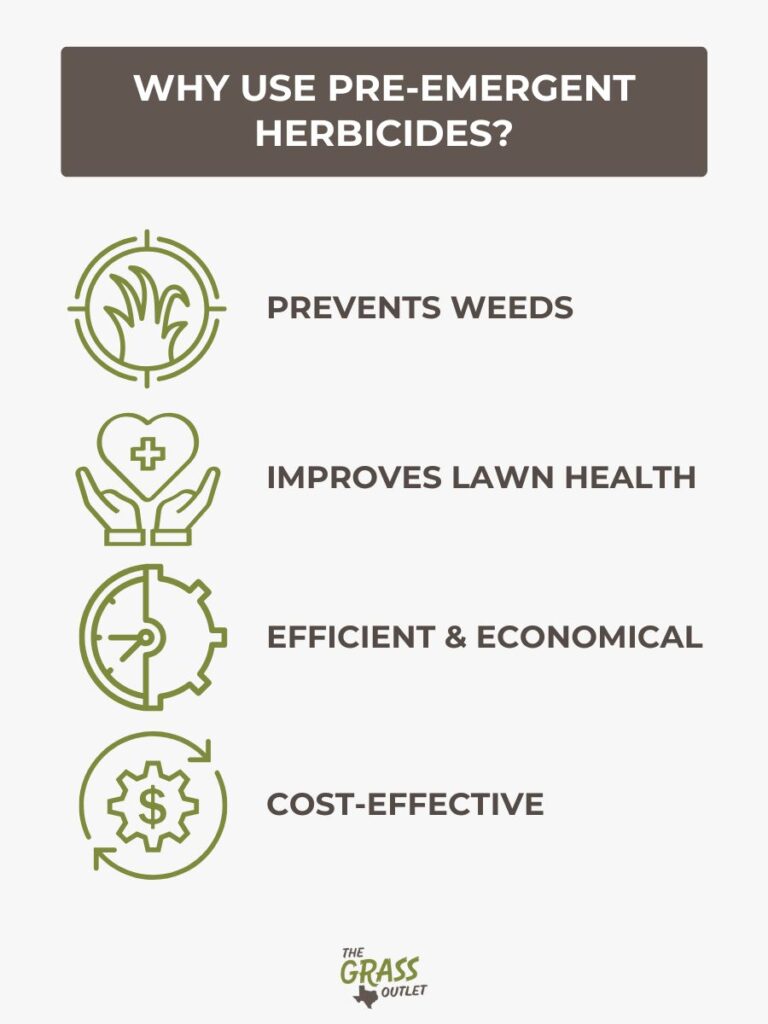
Pre-emergent herbicides prevent germination, meaning weeds won’t utilize valuable resources such as water, nutrients, and sunlight. This allows the grass to use these resources for its growth.
Without weeds, the grass can thicken and become more resistant to drought and disease. A dense lawn also naturally prevents new weed seeds from germinating because the thick grass blocks the light needed for weed seed germination.
Regularly applying pre-emergent herbicides is a preventive measure that stops the problem before it starts. This is a more efficient and economical approach than reactively treating already-emerging weeds.
When pre-emergent herbicides are used regularly, the need for post-emergent herbicides, which are used to kill already emerged weeds, is reduced. Post-emergent herbicides are often more aggressive and expensive, and their frequent use can damage the lawn and surrounding plants.
Preventive weed control is often cheaper than combating already emerged weeds. Regularly applying pre-emergent herbicides can reduce overall costs for herbicides, labor, and additional lawn care products.
What Do Experts Advise, and What Else Should You Consider?
It is always beneficial to hear the advice of experts with extensive experience in lawn maintenance and their insights regarding the use of pre-emergent herbicides.
First, always choose an herbicide specifically designed for your type of grass. Most are formulated for clearly defined grasses and weeds.
Wait at least 60 days after overseeding or sodding – or until you have mowed twice before applying a pre-emergent herbicide.
If you are considering laying new sod, wait at least 60-90 days after applying a pre-emergent herbicide.
Additionally, do not apply it to grass suffering from drought or not fertile.
What Are Some Other Useful Tips?
- After applying the herbicide, avoid aerating the lawn or removing the thatch layer.
- Ensure the lawn is drained after application so the herbicide can reach where the seeds germinate.
- Do not use a sprinkler system to apply the herbicide, which can harm the broader ecosystem.
- Very importantly, do not fertilize simultaneously. The water used to irrigate the lawn after fertilization will move the pre-emergent herbicide too deep below the soil surface, rendering it ineffective.
Conclusion
Proper use of pre-emergent herbicides enhances the aesthetic appearance of the lawn and contributes to a healthier ecosystem and more economical lawn management. For optimal results, lawn owners should monitor weather conditions, soil temperature, and their lawns’ specific needs.
Pre-emergent herbicides prevent weed germination, reducing competition for resources and allowing the grass to thicken and become more resilient. This proactive solution minimizes the need for more aggressive post-emergent herbicides, lowering the ecological footprint and long-term maintenance costs.
Feel free to contact The Grass Outlet if you have any further questions on this topic.





